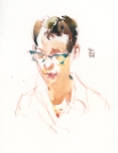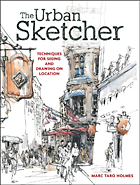Sketching the Sketchers
Here’s some little portrait sketches from our last USK:MTL dim sum lunch.
There’s a style right now for brightly colored eyeglass frames that makes for fun drawings. My feeling on drawing eyeglasses is – don’t draw the entire frame. Leave some of it to the imagination to avoid overpowering the face.
I suppose that is weird advice – because I can say that about absolutely anything. Don’t draw everything you see :) Less is more. Make the viewer interact with the sketch. Make the brain interpret the lines. It’s more fun for everyone.
I still had my small vial of diluted ink to draw with. I think it really works for these little portraits. They’re in a 6×9″ pad of Strathmore 400 watercolor paper. I had thought these were cheap little pads (I bought them in a Michaels in some small town, as emergency back up on a trip). But it’s actually very nice paper. I finally realized, when it comes to Strathmore paper, the higher the number the better (300,400,500).





There’s a lot of realism and light in these portraits … excellent how you also leave something to the imagination. Great technique!
Good info.! Thanks.
Love the light in these portraits. It’s such a balancing act between the lights and little hits of dark that give these faces (and anything else we draw) depth and realism.
I really enjoy seeing your work. These portraits have life! . There is more energy or movement in a sketch when lines are missing or open. I have a question on the diluted ink…are you using it with a dip pen or fountain pen?
Dip pen in this case, just to save time loading a pen – as it was only a test run :)
Thank you. I will have to try it!
Great work, Marc, as always. You say so much with so few strok
es.
Really nice loose work – well done!
Nice work, Marc. Looking at your line width variation– if I may ask, what kind of nib are you using? I can’t get that kind of line variety with my typical dip pen nibs.
I have a kind of grab bag of hand-me-down nibs. I’m not even sure what they all are. The two I like, that are most commonly in shops around here: a Japanese crowquill called a Zebra “G” nib (used for fine lines), and a bigger, more flexible Brause 361 Steno also known as The Blue Pumpkin for its round ink reservoir and gunmetal blue finish. I also use Brause 0.75 and 2.5mm Chisel Tips for bolder accents. (These are the kind with the the little reservoir clipped on top).
These are great – lovely work as always, :-)
I love the skin tones and your limited pallet. Beautiful
Nice sketches and I appreciate your explanations as well. I’ve been using the Strathmore 500 paper in a sketchbook and am very happy with its quality and durability- it can take a lot of heavy washes without any damage. I also like to see you working almost in monochrome with spectacular results.
Crazy place for this question, but..some months ago you wrote something about your PShop process for processing scanned images before printing on watercolor paper. I’d appreciate your directing me to the blog I’m referring too. Thanks, Larry
Hey Larry – well, you might be thinking of this one where I show how I collage drawings into a composition before painting:https://citizensketcher.com/2015/02/01/life-sketching-vs-studio-montage/. There is also this one on piecing together large drawings: https://citizensketcher.com/2012/04/26/how-to-do-huge-sketches-in-the-field-and-not-carry-a-lot-of-stuff/. And this one on removing paper texture might also help: https://citizensketcher.com/2015/02/11/good-question-of-the-week-why-is-there-no-paper-texture-in-your-scans/